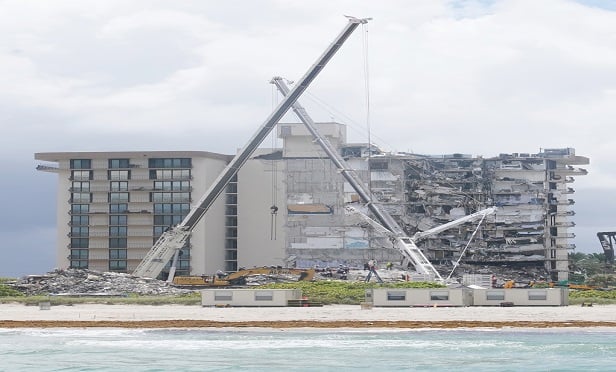Adjusting complex losses: Lessons learned from the Champlain Towers South collapse
Each loss is unique but complex claims take time, planning, resources and patience to investigate and settle.

Many adjusters and investigators are following the investigation into the collapse of the Champlain Tower South condominium collapse with great interest, mainly because they want to identify ways they can improve their skill sets and knowledge on future claims. For those who haven’t handled claims of this magnitude before, here are some practical recommendations:
- Understand that large losses will implicate excess and umbrella policies, so be sure to provide notice to all potential insurers as soon as possible. These types of situations typically involve market meetings, where you provide updates and answer questions on a monthly or quarterly basis to all those involved
- Immediately retain your team that will help manage this loss, including defense counsel, possibly coverage counsel, forensic engineer(s) (especially if there are multiple disciplines needed), forensic accountant, building consultant, appraiser, salvage vendor, contractors and more. Large losses are unique in that they require a lot of orchestration between the team members, and the adjuster is the conductor. As opposed to smaller losses where adjusters may actually do the work themselves, in large losses they typically act only in a project management role and delegate individual tasks, including conducting interviews, policy reviews, drafting estimates and the like to others. This author has been involved in projects that involved over 100 people, including 20 adjusting staff, five attorneys, 25 experts, four forensic accountants and more than 50 contractors. For projects that large, you can’t get bogged down in the day-to-day issues.
- Preserve all physical and electronic evidence. Assume this case will go to litigation and take the steps necessary to ensure that all evidence is preserved and will be available to your team for review, as well as the other side’s counsel and expert team.
- Identify any potential evidence from third-party sources and take immediate steps to collect. For Surfside, that includes any video cameras in the area, reviewing social media posts to find pictures/videos of the collapse and identifying witnesses who may have been in the area.
- Meet with the local authority and attempt to establish a cooperative working relationship. The local jurisdiction will have a list of priorities, namely determining if any criminal acts were committed as well as the life and safety concerns of residents and the general public. Many times these folks are under-funded and under-trained, so you and your expert team can establish a very cooperative relationship with these folks early on and provide them with expertise and resources much more efficiently than they may be able to procure on their own. This author has been involved in death cases where the OSHA inspector followed us around while we conducted our investigation and allowed us to be involved in the entire process of him developing his report. We didn’t provide any interference or undue influence, but access to all of the evidence is critical to being able to determine cause beyond a reasonable doubt.
- Identify potential conflicts of interest and segregate defense counsel to the various parties as necessary.
- Recognize that at a minimum, several depositions will be taken, so engage a psychologist or witness prep expert to help manage the direct testimony of your corporate representatives and your fact witnesses. These early depositions will help you control the narrative and positively influence public opinion if the litigation continues.
- You will want to work closely with the insured, their crisis management team, their public relations team and, to the extent that you can, provide a unified front and let the policyholder be the person front and center for all public-facing interviews and press statements.
- Understand that even under the best circumstances, large loss investigations typically stretch out into months and sometimes, years. For that reason, you need to work with all of your vendors proactively to help them manage cash flow because you can’t expect your vendors to pay for 10 months’ worth of work out of their pocket. Typically, monthly status reports with invoices for work to date are sufficient to keep everyone from being financially strained.
- Understand that you will experience a small number of problems along the way. These types of things never go perfectly. People get sick, sometimes people change companies during a project and occasionally you may have to fire a vendor and replace them. Personal relationships are so important in this business because you can have weekly meetings with your group and they will bring up their challenges if they trust you to help them manage them.
- Understand that large losses present a unique opportunity to train younger staff members. Given the size of the losses as well as the long time duration, identify strategic opportunities for some of your less experienced adjusters to participate in various aspects of the loss, even if some of the time is non-billable. The same applies to your vendors. Talk to them about expectations of when senior staff will be necessary, but what tasks and activities junior staff members would be able to serve in as well.
Complex claims take time, planning, resources and patience to investigate and settle. The collapse of the Champlain Towers South condominium in Surfside will provide insurers with a case study to be examined for many years to come.
Timothy D. Christ (timothydavid.christ@gmail.com) is a well-known thought leader and speaker in the insurance industry, with over 20 years of experience in forensic engineering and claims investigations, including a published book on these topics. Much of his consulting work centers on the future of claims and the impacts of technology.
Related:

